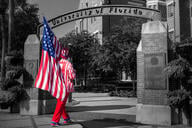You have /5 articles left.
Sign up for a free account or log in.
The intensifying and increasingly caustic debates over federal immigration policy has reinforced the extent to which the United States is a land of immigrants (legal and not). But few things drive that point home as much as the Modern Language Association's newly revamped Language Map, which the scholars' group formally unveiled Tuesday.
Sure, you wouldn't be surprised that there are more than 28 million speakers of Spanish, who can be found in every state in the country, and 41,300 speakers of Slovak in 44 states and the District of Columbia. But Nilotic (2,990 in 17 states)? Berber (435 in 6 states)? Potawatomi (844 in 8 states)?
The association of literature and language professors first introduced the map project in 2004, and 125,000 visitors -- scholars, government officials and elementary school geography teachers and their pupils -- have since used it for a range of purposes. But while the version the MLA showed off Tuesday, like its predecessor, uses 2000 Census data to show who speaks what in their homes on a county by county and zip code by zip code basis, the new map is significantly expanded and refined.
Among other things, it includes information about 300 languages, up from 30; breaks down the language speaking population into three age categories (up from two), so that children can be compared with their grandparents; provides numbers and percentages of language speakers for each county (as opposed to just numbers); includes statistics on the population’s English language proficiency; and (for you cartographers out there) now uses colors that are consistently sequentially graded.
“What’s important about the map is that it demonstrates that the United States, with the exception of Papua New Guinea, is the country in the world that has the greatest diversity of languge," said J. Michael Holquist, professor of comparative literature and Slavic at Yale University and vice president of the MLA. "It's clear we have a resource in this country" -- in the form of speakers of many languages -- "that is not available in the rest of the world."
Many of those languages, Holquist and others pointed out, are in danger of extinction. While the map project shows that there are 125 languages spoken by a "significant number" of speakers -- between 1,000 and 100,000 people in the United States -- 60 of the 300 languages are spoken by fewer than 100 speakers, said Rosemary G. Feal, executive director of the language association. "They are tiny and in peril," she said.
Feal said the map had been, and would continue to be, an important resource for many different types of people and for many distinct purposes: Linguists, sociologists and other scholars who study language and cultural patterns. State and other agencies, like the Red Cross, that seek to better understand the populations they serve and what kind of translation and other services they need to offer. Teachers trying to instill in their students an understanding of the interplay of language, culture and geography. And, increasingly, Feal said, federal policy makers, in and out of the military, who are promoting the importance of language study for national security and diplomacy, as part of a new Bush administration effort.
"We hope this encourages communities to think about offering a wider range of languages to their students and providing more immersion opportunities, to take advantage of the language expertise we have right here," said Feal.





